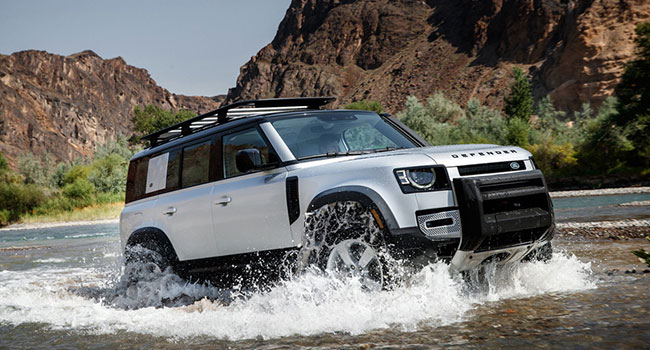
Available in two versions, the Defender is arguably the most utilitarian –and retro – model in the company’s lineup. It conveys a sense of ruggedness and capability that sets it apart from most other Rover products
 In one of my favourite movies – The Gods Must Be Crazy – a hapless protagonist inadvertently winches his old Land Rover to a massive tree branch and immediately forgets about it.
In one of my favourite movies – The Gods Must Be Crazy – a hapless protagonist inadvertently winches his old Land Rover to a massive tree branch and immediately forgets about it.
When he remembers what he’s done, the trusty Rover has winched itself off the ground and is hanging in the air like some kind of huge mechanical fruit.
That’s the kind of stuff that has cemented Range Rover’s reputation as a builder of durable, almost indestructible off-road SUVs that can go just about anywhere and are as universally admired for their toughness as Jeep.
The company has been through some changes over the years, and is manufactured in various facilities around the world – the Defender is made in Slovakia, and other models are made in India, Brazil and, of course, Great Britain. But Land Rover still maintains that aura of invincibility.
I recently spent some time with the latest iteration of the Land Rover Defender.
Available in two versions, the Defender is arguably the most utilitarian –and retro – model in the company’s lineup. It conveys a sense of ruggedness and capability that sets it apart from most other Rover products.
My tester, the 110 SE, is powered by a six-cylinder engine that develops 295 horsepower. It’s mated to an eight-speed automatic transmission and comes with all-wheel drive. It delivers a purported 12 litres/100 km combined fuel rating, so it’s not exactly a gas sipper.
Some notes:

With goodies like a heated steering wheel, heated/ventilated seats, satellite radio, etc., it’ll run you just under $80,000. For a vehicle that’s meant to go off-road, that’s a lot of coin
The auto stop/start feature is crude and annoying and really interferes with smoothly operating the vehicle. Yes, it shuts it off to prevent excess idling, but it does so at the least practical times – while parallel parking, for instance. Every time you stop to go into reverse or drive, it shuts the car off and then lurches back into action, making you look stupid and making a relatively simple task much more complicated than it should be. This is the car’s worst feature.
The gear shifter is fussy and counterintuitive. It doesn’t get along with the auto-stop feature and detracts from the driving experience. I never got used to it.
The drivetrain is refined and powerful. Reserve power for overtaking is impressive and aside from the auto stop/start, there’s nothing to complain about here. Going hand-in-hand with this is top-notch noise, vibration and harshness – the 110 is beautifully silent on the highway.
Be prepared for a somewhat choppy ride. The Defender is an upscale SUV, yes, but it retains some vestiges of its utilitarian past. The ride is a little tippy and perhaps less refined than some buyers might be used to. The vehicle feels like it’s perched high off the ground but it’s actually very stable.
Happy to see that Rover has normalized its switchgear. Some of the older Land/Range Rovers were almost undriveable because of the insane ergonomics and switchgear. No problems here, although the radio controls could be better, but there you go.
Excellent front seats and peripheral visibility, with a nice high driving position. I looked forward to sliding behind the wheel of this one and aside from the shifter, etc., I got along with it famously.
This is not a cheap car. My tester, with goodies like a heated steering wheel, heated/ventilated seats, satellite radio, etc., will run you just under $80,000. For a vehicle that’s meant to go off-road, that’s a lot of coin, it seems to me.
This is a strange market. The Defender is more than capable off-road but the percentage of buyers who will actually take it there is miniscule – some say less than two per cent. It’s not hard to see why – if you’ve shelled out close to $100,000 (after taxes, etc.), the last thing you want to do is go barging into a mud-hole, scrambling over fallen trees or hopping across boulders.
But you could if you wanted to.
2021 Land Rover Defender
Engine: 3.0-litre six-cylinder
Transmission: eight-speed
Drive: all-wheel
Horsepower: 296
Torque: 295
Base price: $79,500
Fuel economy: 14.0 litres/100 km city and 11 to 12 litres/100 km highway, with regular fuel
Some alternatives: Porsche Cayenne, Hyundai Genesis GV80, BMW X5,Volvo XC90, Audi RS Q8, Cadillac XT5, Mercedes GLE, Lexus NX, Acura MDX
Ted Laturnus writes for Troy Media’s Driver Seat Associate website. An automotive journalist since 1976, he has been named Canadian Automotive Journalist of the Year twice and is past-president of the Automotive Journalists Association of Canada (AJAC).
For interview requests, click here. You must be a Troy Media Marketplace media subscriber to access our Sourcebook.
The views, opinions and positions expressed by columnists and contributors are the author’s alone. They do not inherently or expressly reflect the views, opinions and/or positions of our publication.


